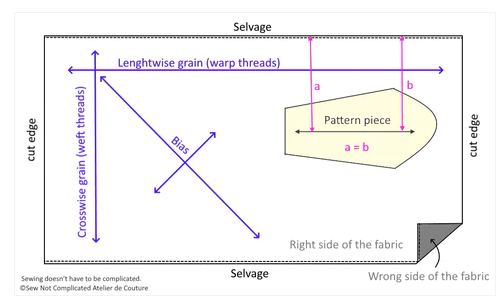
…and furthermore, what is the “bias”, or”the “cross-grain”? This will be a quick, but very important lesson on fabric handling and cutting.
Fabric is composed of interwoven (often perpendicularly woven) fabrics. When fabric is being woven– there is the first section of fabric is hooked into the loom and provides tension for the loom to shuttle across. This is called the “selvedge”. In non-wovens, this is the section of the fabric that has a manufacturer-finished edge– rather than the cut length of fabric. The “grainline” is the line fabric takes as it runs parallel along the selvedge. The “cross grain” is perpendicular to the selvedge, and the “bias” runs at a 45 degree angle– perfectly diagonal from the grainline, or 45 degrees for those who remember their geometry class.
I know when I’m learning something, I want to get to the most important question of all: WHY?!? This cursory information is all nice and dandy, but why do we care about grainlines? Why does it even matter what direction I cut my pattern out in, especially if the fabric is not a plaid or a print? Does it actually make a difference?
The answer to that question is a resounding YES! Why does it make a difference? Because the fabric will drape and behave differently depending on where it is cut out. If you know exactly what you are doing, you can make incredible shapes and expertly manipulate your fabric. If you “forget” about the grainline like I did for probably my entire first year of sewing, you’re going to have some weird outcomes and probably feel pretty unsatisfied with the fruits of your labor.
The details of textile technology can get pretty granular, so we’re just going to keep it as simple as possible for now:
When fabric is cut on the grainline, it is very tight, controlled and less likely to warp. This obviously depends on your fabric type, but this is the general truth with wovens. The grainline is your go-to for a tailored look. If you want dramatic, clean lines… you want the grainline.
When fabric is cut on the cross grain, there is usually a little give to the fabric… There is a little more room for movement, but there is a bit of a roll to the fabric. This is a great way to cut if you’re looking for a billowy garment or you want to create something with bold gathers. Cross grain fabrics tend to pull away from the body, and will generate volume if that’s what you’re looking for.
Last but not least, lets discuss the darling of the sewing world: the bias. If you’re looking for a beautiful, body hugging drape, or a little looseness, a stretch in your garment, you want to cut on the bias. This is the natural choice for fabrics like silk charmeuse or 4-ply. Working with bias cut fabric (especially something slippery like silk charmeuse) can be daunting for a beginner, because it loves to shift. Pinning becomes highly important when working in this direction, if you plan to preserve the shape of your design or pattern!
The above does not necessarily apply to certain stretch fabrics or to knits. Fabrics like leather also do not have a grainline.
Suffice it to say– knowing about the grainline and how to manipulate it is vitally important to a good sewing outcome. I invite you to start playing with grainlines — you can practice using toile fabrics. The more you work with materials, the more you get to know them, and before long you’ll be a master of the grainline.

Leave a Reply
You must be logged in to post a comment.